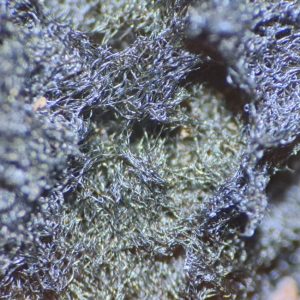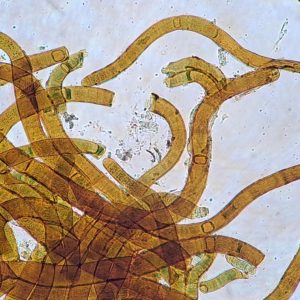A mass of cyanobacteria on a roadside in Anson County, NC. Photo by Becky Dill.
What would you think if you saw the above mass on the side of the road? Some sort of funny lichen?
That’s what community scientist Becky Dill thought when she spotted this “unknown lichen-like substance” on a roadside outcrop in Anson County, NC. She sent a specimen to the UNC Herbarium (NCU), where lichen curator Gary Perlmutter investigated.
It turns out this mystery substance was not a lichen, but a photosynthetic bacteria (Cyanobacteria) in the genus Scytonema! According to Wikipedia, bacteria in this genus grow “in filaments that form dark mats. Many species are aquatic and are either free-floating or grow attached to a submerged substrate, while other species grow on terrestrial rocks, wood, soil or plants.”


Cyanobacteria are one of the most ancient lineages of life on earth: they’ve been around for at least 2.1 billion years and are probably responsible for the Great Oxidation Event that first introduced large amounts of oxygen to the atmosphere. More primitive even than algae, research suggests cyanobacteria are the ancestors of modern plants.
Becky Dill’s cyanobacteria was terrestrial, growing on a rock outcrop. NCU curates seven other specimens of Scytonema in the Max & Fran Hommersand Algae Collection: S. crispum (collected in 1891 in Connecticut by William Albert Setchell), S. figuratum (collected in 1901 in Connecticut by Isaac Holden), S. figuratum (collected in 1940 by Victor Lindauer in Northland, New Zealand), S. guyanense (3 specimens collected in 1915 by N. Wille in Puerto Rico), and S. ocellatum (collected in 1915 by N.L. Gardner in Sonoma, California).
